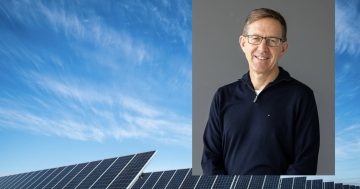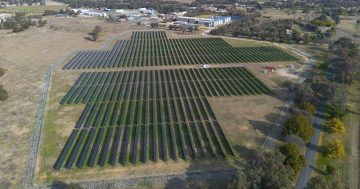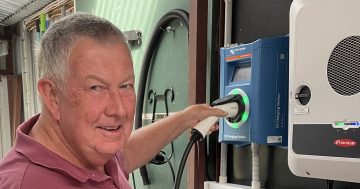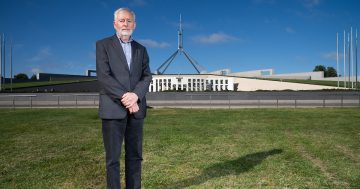
Dr Jun Peng and Associate Professor Thomas White from the ANU College of Engineering and Computer Science with the next-generation perovskite solar cells. Photo: Lannon Harley, ANU.
Researchers from the Australian National University (ANU) are holding the future of solar energy efficiency in their hands, and it takes the form of a highly-efficient perovskite cell.
You may not have heard of perovskite cells, but they are being touted as the most efficient form of solar energy, with the research team setting a new record for the largest amount of sunlight hitting the cells being converted into energy.
They achieved a rate of 21.6 per cent efficiency, the highest ever achieved for perovskite cells above a certain size. This means 21.6 per cent of sunlight hitting the cells is converted into energy.
Associate Professor Thomas White says as a comparison, typical solar panels being installed on rooftops right now have efficiencies of 17-18 per cent.
The research provides a glimpse into the future of solar technology.
“There are three things you’re trying to achieve with solar cells, you’re trying to make them efficient, stable and cheap,” Associate Professor White said.
“Perovskites are the future of solar cells.”
“With perovskites, the efficiency is now competitive, and the cost is one of the big selling points. The real challenge now is making them stable enough to be used on a rooftop for example, where they have to be able to last 25 to 30 years in extreme temperatures.
“Ultimately, the aim is to combine these perovskites with silicon in a tandem solar cell. Putting the two materials together can potentially give us higher efficiencies than either one alone.”
According to Geoscience Australia, Australia has the highest solar radiation per square metre of any continent and consequently some of the best solar energy resources in the world.
The Australian Energy Market Operator estimates six solar panels per minute are being installed across Australia. Add in large-scale solar projects, and the figure rises to 10-20 panels every 60 seconds.
The surge in solar also provides a new industry for electricians, with thousands signing up as solar installers.
In Canberra, analysis this year by solar energy consultancy SunWiz shows that 22,120 homes in the ACT have rooftop solar panels.
That is about 15 per cent of homes in Canberra. Across the country, 20.3 per cent of homes have solar panels, with South Australia leading the way at 31 per cent.
The ACT Government has a target for 100 per cent renewable electricity by 2020. Most of that renewable energy is coming from wind farms in South Australia, Victoria and NSW, while a smaller fraction is coming from solar farms within the ACT.
Associate Professor White and his team have been working to improve perovskite solar cells for years.
He said perovskite materials combine abundant and cheap chemical elements including carbon, hydrogen, nitrogen, iodine and lead.
“Ninety-five per cent of solar cells are made of silicon at the moment. It’s a very, very good material, but it’s going to reach the upper limit of its efficiency in the next five or 10 years,” Associate Professor White said.
“To be able to make a really good tandem solar cell you’ve got to have both of your cells operating as efficiently as possible. Because silicon can’t get much better, we’ve been focusing on the perovskite half.”
The new efficiency record means perovskite cells can now produce 216 watts of electrical power per square metre.
“When they’re very small it’s difficult to measure them accurately, and it’s not necessarily representative of what would happen if you scaled up,” Associate Professor White said.
“So our result is the highest on a scale that many consider the minimum – one square centimetre.”
To achieve the record result, co-researcher Dr Jun Peng developed a novel nanostructured material.
“An efficient solar cell must be able to produce both high voltage and high current,” said Dr Peng.
“It can be difficult to achieve both at the same time, but the nanostructured layer in our cells makes this possible.”
The team’s results were independently verified by the CSIRO Photovoltaics Performance Lab, the only laboratory in the Southern Hemisphere accredited to certify solar cell efficiencies to international standards.
The study was completed with the assistance of Australian Renewable Energy Agency funding.
Original Article published by Michael Weaver on The RiotACT.















